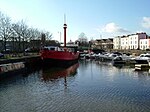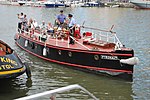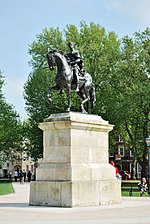Robinson's Warehouse, Bristol
1874 establishments in EnglandBrick buildings and structuresBristol HarboursideBristol building and structure stubsByzantine Revival architecture in the United Kingdom ... and 5 more
Grade II listed buildings in BristolGrade II listed industrial buildingsIndustrial buildings completed in 1874Use British English from August 2017Warehouses in England

Robinson's Warehouse (grid reference ST585725) is a warehouse on Bathurst Parade, on the Floating Harbour in Bristol, England. It was built in 1874 by William Bruce Gingell, and is an example of the Bristol Byzantine style with yellow and red brick and Moorish arches.It was formerly the warehouse of Robinson's Oil Seed Manufactory, and has also been known as Warriner's Warehouse. It has been designated by English Heritage as a grade II listed building.
Excerpt from the Wikipedia article Robinson's Warehouse, Bristol (License: CC BY-SA 3.0, Authors, Images).Robinson's Warehouse, Bristol
Bathurst Parade, Bristol Southville
Geographical coordinates (GPS) Address Nearby Places Show on map
Geographical coordinates (GPS)
| Latitude | Longitude |
|---|---|
| N 51.4475 ° | E -2.5951 ° |
Address
Bathurst Parade
BS1 6UA Bristol, Southville
England, United Kingdom
Open on Google Maps











